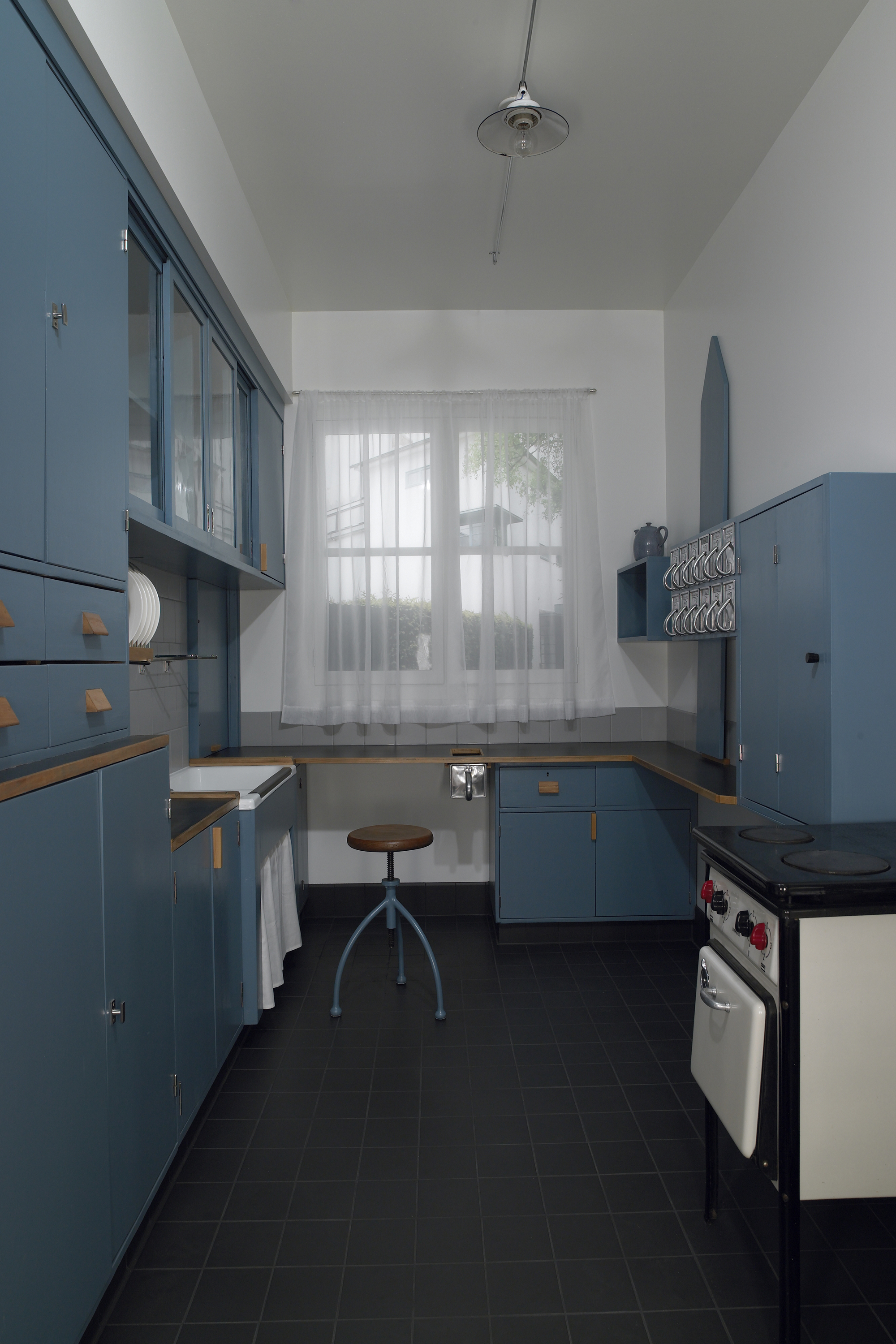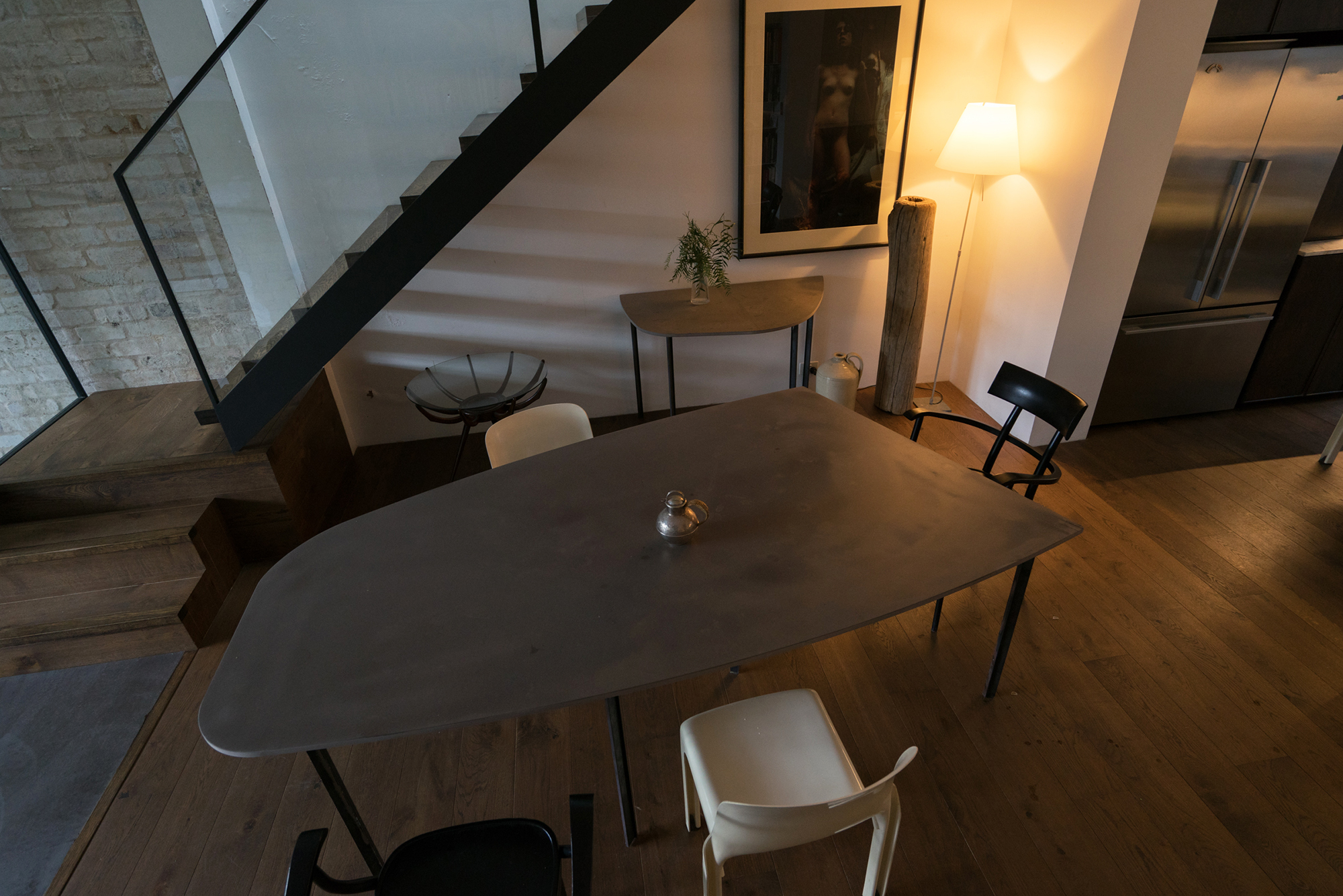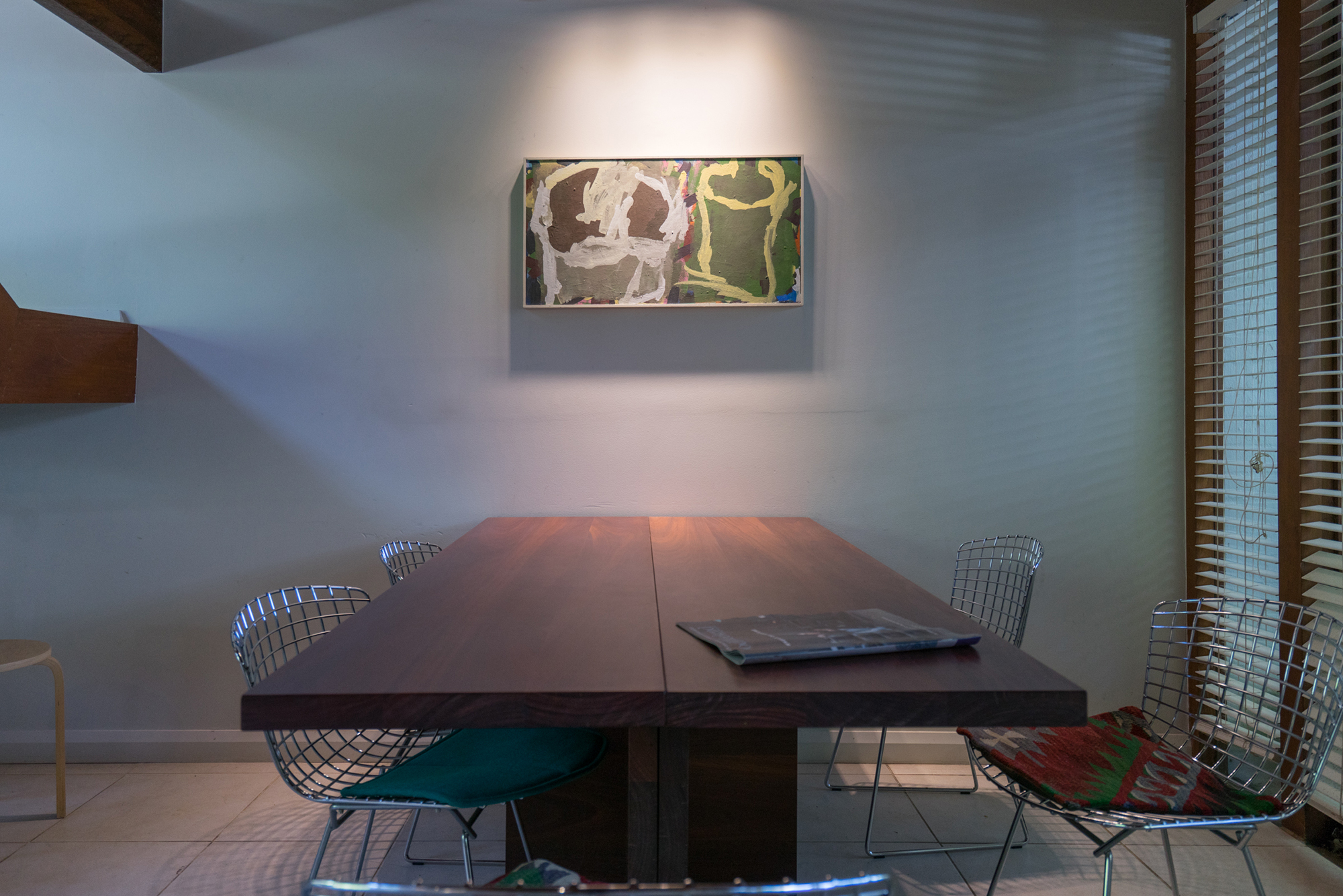The invisible ideologies behind the dining table

‘I was curious to explore the response of unconventional families to dining practices, by looking at the role of dining tables in the homes of architects who have considered the dining ritual to the point of designing their own tables. The families interviewed – partners Andy Macdonald and Telly Theodore, and married couple and business partners Penny Collins and Huw Turner – represent ‘radical families’, divorced from the limited domestic roles of breadwinner/housewife. Their thoughtfully designed tables determine their own dining rituals and reflect their domestic politics.’
Objects relate a particular ideology and have political power. Henri Lefebvre notes in The Production of Space that space is representational and exists through “attendant imagery and mythic narratives”.
The pervasive image of the dining table as a symbol of the contentment of the nuclear family is one of these “mythic narratives”. The inability to live up to this vision can be a source of shame and anxiety: in Terrence Malick’s 2011 drama The Tree of Life, set in 1950s Texas, the ritual of the family meal is upheld despite being a site of discontent. Tense legs beneath the tabletop belie an undercurrent of strained voices, eroding the image of familial togetherness. The contradictions expose the dining table as a field of family politics, an expression of domestic ideology: of how we should live.
The rectilinear dining table reinforces traditional domestic roles: the man is positioned at the physical and metaphorical ‘head of the table’. A circular dining table, on the other hand, articulates equality. There are no power relations or hierarchy built into the circular table given that there is no privileged surface.
The illusion that the ‘traditional family dinner’ is a timeless convention is perpetuated by the continuity in how we design the dining table, the dining room, the kitchen. But the dining table is not timeless. As Jack Self – architect and director of the Real Foundation – remarks, “Everything we think of as being normal in the home, everything we think of as being traditional– they’re all inventions.”
The dining table and the formal dining room arrived in Australia with the colonial settlers, as a representation of traditional family values inherited from Britain. Separated kitchens and dining rooms were the domain of the British upper class, while middle-class families often combined their cooking area with a variety of functions, like sleeping and living, as Thomas A. Markus and Deborah Cameron describe in their book The Words Between the Spaces: Buildings and Language.
A room specifically for dining developed as Modernism revolutionised the middle-class kitchen. Margarete Schütte-Lihotzky, Austria’s first female architect, effectively invented the modern kitchen in 1926. The “Frankfurt kitchen” separated the activity of cooking from the rest of the house by creating a compact ‘housewife’s laboratory’. This simplified domestic labour by isolating it from other activities and maximising spatial efficiency. At the Bauhaus’s Haus am Horn exhibit of 1923, Benita Koch-Otte’s kitchen demonstrated a similar functionalist approach to domestic life, echoing Le Corbusier’s sentiment that the house should be a “machine for living”.

While reframing cooking as ‘work’, the Frankfurt kitchen also consolidated expectations of women’s unpaid domestic labour by making the activity less social. Only one person could fit in the kitchen – and that person was a woman. As Modernist kitchens slipped into suburbia, the dining room developed as a separate space to the kitchen with its own dedicated table.
Since then, thousands of kitchen walls have been demolished to make way for open plan living spaces. A 2014 survey conducted by Allworth Master Built Homes found that 83% of Australians consider the open plan living space to be the most important room in the house. Refusing benefits like efficiency, acoustic control and odour reduction, the turn towards open plan living spaces indicates a revival of the dining ritual as a social event. With family members no longer congregating around the one television, but each having access to their own laptop and streaming service, the dining table – now often situated in an open-plan living – is reoccupied as a surface of social significance. The kitchen is now the heart of the home.
But the promise of the rectangular dining table as a dream of suburban perfection still lingers. Walking through the five giant levels of SPACE Furniture, a large warehouse of curated contemporary design in Sydney’s fast gentrifying industrial suburb of Alexandria, I noticed how traditional the dining table design still was. Scattered between eccentric renditions of lamps, chairs and couches, they were mostly rectangular or circular tabletops with legs. I was reminded of Sara Ahmed’s reflection on “the sheer force of the regularity of that which is familiar: how each table presents the same form of sociality as the form of the heterosexual couple. How is it possible… that the same form is repeated again and again?” How is it possible that, in a world of working mums, same-sex marriage, home delivery and streaming services, we sit down at the end of each day without considering our dining tables?


When I enter Andy Macdonald and Telly Theodore’s living room on a hot 40-degree Sunday, tucked away in a pocket of Glebe in Sydney’s Inner West, the centrepiece of the afternoon is the table in the kitchen area, around which dinner guests have congregated.
The table itself is a prototype designed by Andy and Telly, who are both architects: Andy is the director of Mac-Interactive Architects, while Telly works as an architect and interior designer and is the director of Telly Theodore Allied Office (TTAO). They once lived with a rectangular table, but it just didn’t work. As Andy says, “We couldn’t wait to get rid of it. It was sitting in this very square space, it was just too much.”
Telly continues: “A rectangular table prescribed something restrained, whereas the way that it is now, it generates a lot more of ways to use it.” The current table is a space-specific, irregularly curved table that sits next to the kitchen overlooking the sunken living room below. The table can comfortably accommodate up to ten people. Today there are seven.
The table adjusts to varying circumstances. As Andy says: “It does prescribe where you can sit, but I actually think that’s one of the really nice things about the shape of the table. If it’s just the two of us, we sit right at the end and we’re really close. If we’re having a few people around we’ll sit four really comfortably around the centre.” When not in use, the table can separate so that one quarter is docked against the wall as a side table. Most of the time, Andy and Telly eat dinner at the coffee table overlooking the garden. The dining table is rarely used, aside from entertaining. “I guess it kind of formalises things for us. It distinguishes itself from the everyday,” notes Telly. The use of the coffee table as a dining table provides a more intimate and casual response to everyday living.
Penny Collins and Huw Turner are directors of Collins and Turner, an architecture firm based in Surry Hills. Ironically, their Paddington terrace is as-of-yet unrenovated. When they moved in, a couple of years ago, Huw drew up plans for joinery in every room, but the only thing that they could agree to spend money on was a dining table.
Their dining table is an iteration of a dining table that they designed for a previous client, James Mould. Unlike James’ reclaimed Oregon pine table, Penny and Huw’s table is solid jarrah timber, chosen to match the house’s darker timber detailing. The heavy timber was a response to the solid dining tables of their youth. As Huw remembers fondly: “At my house, when I was a kid, we had a solid pine table. That table lasted forever, and it got dings in it and scratches, and I probably drew on it when I was a kid, but all that stuff didn’t matter because you could sand it down every 10 years if you wanted to. Should be the same with this.”

This table, too, was designed to reconfigure for different scenarios. The rectangular dining table is split lengthways in two halves so that it can transform into a long sideboard if necessary.
Penny and Huw rarely separate the dining table in their own home. Their dining ritual is quite traditional on the face of things, aside from the fact that it is Huw that cooks every night after coming home from the office. Penny will continue to work by sitting at the dining table in the kitchen annotating drawings or responding to emails. As Penny says: “I’ve got different roles in the house.”

Penny and Huw are hardly alone in their adjustment to traditional roles. The dining ritual is being reinvented in contemporary Australian society, as limiting domestic roles are being continuously challenged. Australian women are working more and contributing less unpaid domestic labour to the household. In 2016, 59.3% of Australian women were engaged in the workforce, a 15.9% increase from February 1978. Since 8 December last year, same-sex couples have been able to marry in Australia.
On the night I visit Penny and Huw’s, Huw is busy cutting onions, while their daughter Phoebe shells edamame; Penny is still working. The open-plan living room, which easily connects the living and dining rooms, allows the process of cooking and preparing a meal to be very social. Cooking is no longer behind-the-scenes and nor is it ‘women’s work’: Penny is able to watch Huw while working.
While at the dinner table, the family discusses their week and what they have recently been watching on Netflix: they remember briefly how they used to watch Grey’s Anatomy together on the television in the living room. Despite the elaborate meal, says Huw, “the social aspect of it and coming together as a family is more important than the food.”

The dining table has been reinvigorated as the site of family communication, now a site of resumed importance. And yet, society’s divergence from the outdated and restrictive patriarchal roles of ‘man’ and ‘woman’ subverts the foundation of the traditional dining table as a symbol of family unity. When I ask Andy and Telly how often they entertain, they laugh: “Way too often! We love to entertain, we love our friends.” In their consideration, the act of sharing food, which Telly terms a “sort of exchange”, extends beyond family to include friends, expressing a redefined role of the formal family dinner.
A family could easily eat dinner separately; they could eat in individual rooms on individual tables; the dinner could be a series of ten small courses and after dinner the family could gather in the garden. The traditional family dinner is as much an invention as this scenario: that the woman prepares the dinner, that the man pays for it, that it is the largest meal of the day and that we use cutlery and crockery. The only difference between the two is that the traditional family dinner is an invention accepted by our society – because it reflects our society’s domestic politics.
Dining tables dramatically shape relationships between family members and are the cornerstone of a daily ritual that espouses socialisation and communication. To not consider the dining table is to overlook the power of the dining table as a political object. As Jack Self said, “I do believe my parents divorced because we had a circular dining room table”.
A big thank you to Andy, Telly, Penny and Huw for sharing your thoughts on the dining table with us, as well as your designs. Another thank you to Isobel (Ella) Lord for delving into the invisible ideologies behind the ritual of dining. You can find more of Isobel’s work on her website.